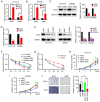RNA m6A methyltransferase METTL3 promotes colorectal cancer cell proliferation and invasion by regulating Snail expression
- PMID: 34457066
- PMCID: PMC8358616
- DOI: 10.3892/ol.2021.12972
RNA m6A methyltransferase METTL3 promotes colorectal cancer cell proliferation and invasion by regulating Snail expression
Abstract
Nitrogen 6-methyladenosine (m6A) is the result of methylation of nitrogen-6 on adenosine, and is the most abundant chemical modification of eukaryotic mRNA. Dysregulation of m6A methylation has been implicated in cancer development and progression through various mechanisms. This type of methylation is primarily regulated by methyltransferase-like 3 (METTL3). However, the molecular mechanisms underlying the role of METTL3 in colorectal cancer (CRC) have not been extensively elucidated. The present study explored m6A modification and the underlying mechanism of m6A, which serve regulatory roles in the development of CRC. It was found that METTL3 is upregulated in CRC cell lines and tissues, and its expression positively correlated with poor overall survival (OS). Mechanistically, the present study demonstrated that METTL3 methylates Snail mRNA, thus stabilizing it to promote CRC malignancy. The present findings indicate that m6A modification is involved in CRC tumorigenesis, and highlight its potential as a therapeutic target against CRC.
Keywords: Snail; colorectal cancer; methyltransferase-like 3; nitrogen 6-methyladenosine.
Copyright: © Wen et al.
Conflict of interest statement
The authors declare that they have no competing interests.
Figures




Similar articles
-
N6-methyladenosine methyltransferase METTL3 promotes colorectal cancer cell proliferation through enhancing MYC expression.Am J Transl Res. 2020 May 15;12(5):1789-1806. eCollection 2020. Am J Transl Res. 2020. PMID: 32509177 Free PMC article.
-
RNA N6-Methyladenosine Methyltransferase METTL3 Facilitates Colorectal Cancer by Activating the m6A-GLUT1-mTORC1 Axis and Is a Therapeutic Target.Gastroenterology. 2021 Mar;160(4):1284-1300.e16. doi: 10.1053/j.gastro.2020.11.013. Epub 2020 Nov 18. Gastroenterology. 2021. PMID: 33217448
-
m6A-dependent glycolysis enhances colorectal cancer progression.Mol Cancer. 2020 Apr 3;19(1):72. doi: 10.1186/s12943-020-01190-w. Mol Cancer. 2020. PMID: 32245489 Free PMC article.
-
Review of METTL3 in colorectal cancer: From mechanisms to the therapeutic potential.Int J Biol Macromol. 2024 Oct;277(Pt 2):134212. doi: 10.1016/j.ijbiomac.2024.134212. Epub 2024 Jul 26. Int J Biol Macromol. 2024. PMID: 39069066 Review.
-
Switching from messenger RNAs to noncoding RNAs, METTL3 is a novel colorectal cancer diagnosis and treatment target.World J Gastrointest Oncol. 2025 May 15;17(5):104076. doi: 10.4251/wjgo.v17.i5.104076. World J Gastrointest Oncol. 2025. PMID: 40487941 Free PMC article. Review.
Cited by
-
Exploration of mRNA-modifying METTL3 oncogene as momentous prognostic biomarker responsible for colorectal cancer development.Open Med (Wars). 2025 Mar 26;20(1):20251167. doi: 10.1515/med-2025-1167. eCollection 2025. Open Med (Wars). 2025. PMID: 40177651 Free PMC article.
-
IMP1/IGF2BP1 in human colorectal cancer extracellular vesicles.Am J Physiol Gastrointest Liver Physiol. 2022 Dec 1;323(6):G571-G585. doi: 10.1152/ajpgi.00121.2022. Epub 2022 Oct 4. Am J Physiol Gastrointest Liver Physiol. 2022. PMID: 36194131 Free PMC article.
-
FTO Inhibits Epithelial Ovarian Cancer Progression by Destabilising SNAI1 mRNA through IGF2BP2.Cancers (Basel). 2022 Oct 25;14(21):5218. doi: 10.3390/cancers14215218. Cancers (Basel). 2022. PMID: 36358640 Free PMC article.
-
METTL3 recruiting M2-type immunosuppressed macrophages by targeting m6A-SNAIL-CXCL2 axis to promote colorectal cancer pulmonary metastasis.J Exp Clin Cancer Res. 2024 Apr 11;43(1):111. doi: 10.1186/s13046-024-03035-6. J Exp Clin Cancer Res. 2024. PMID: 38605400 Free PMC article.
-
m6A methyltransferase KIAA1429 acts as an oncogenic factor in colorectal cancer by regulating SIRT1 in an m6A-dependent manner.Cell Death Discov. 2022 Feb 25;8(1):83. doi: 10.1038/s41420-022-00878-w. Cell Death Discov. 2022. PMID: 35217651 Free PMC article.
References
-
- Degiuli M, Reddavid R, Ricceri F, Di Candido F, Ortenzi M, Elmore U, Belluco C, Rosati R, Guerrieri M, Spinelli A, Members of the Italian Society of Surgical Oncology Colorectal Cancer Network (SICO-CCN) Collaborative Group Segmental colonic resection is a safe and effective treatment option for colon cancer of the splenic flexure: A nationwide retrospective study of the italian society of surgical oncology-colorectal cancer network collaborative group. Dis Colon Rectum. 2020;63:1372–1382. doi: 10.1097/DCR.0000000000001743. - DOI - PubMed
-
- Tang R, Cheng AJ, Wang JY, Wang TC. Close correlation between telomerase expression and adenomatous polyp progression in multistep colorectal carcinogenesis. Cancer Res. 1998;58:4052–4054. - PubMed
-
- Pichler M, Stiegelbauer V, Vychytilova-Faltejskova P, Ivan C, Ling H, Winter E, Zhang X, Goblirsch M, Wulf-Goldenberg A, Ohtsuka M, et al. Genome-Wide miRNA analysis identifies miR-188-3p as a novel prognostic marker and molecular factor involved in colorectal carcinogenesis. Clin Cancer Res. 2017;23:1323–1333. doi: 10.1158/1078-0432.CCR-16-0497. - DOI - PMC - PubMed
LinkOut - more resources
Full Text Sources
Other Literature Sources
Research Materials
